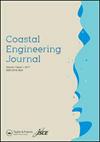Coastal disasters in Asia: Forecasting, Uncovering, Recovering, and Mitigation
IF 1.9
3区 工程技术
Q3 ENGINEERING, CIVIL
引用次数: 0
Abstract
With 60% of the world’s population, low-lying deltas, numerous islands, long coastlines, rapid population growth, and economic development, the Asian coast is the most vulnerable area in the world to disasters. No other part of the world has such a large number of subduction plate boundaries and warm ocean basins, resulting in massive tsunamis, tropical cyclones, and storm surges (Figure 1). In reality, the six worst coastal disasters of the 21st century in terms of number of casualties all occurred in Asia: the Indian Ocean Tsunami (2004), Cyclone Sidr (Bangladesh, 2007), Cyclone Nargis (Myanmar, 2008), the Great East Japan Earthquake and Tsunami (Japan, 2011), Typhoon Haiyan (the Philippines, 2013), and the Sulawesi (Palu) Earthquake, Landslide and Tsunami (Indonesia, 2018). These six disasters have claimed more than 400,000 victims. Natural and anthropogenic environmental degradation, such as coastal erosion, land subsidence, and mangrove deforestation, have also been remarkably increasing the risk of disasters in Asia (Hao and Takewaka 2022; Sreeranga et al. 2022). Locallyintensified tsunamis due to a combination of earthquakes, volcanic eruptions, subaerial and submarine landslides (Heidarzadeh and Mulia 2022; Sabeti and Heidarzadeh 2022) and risks associated with the uncertainty of large thrust earthquakes also need to be further studied and clarified (Momeni et al. 2022). Where major disasters occurred in Asia, recovery has immediately begun with international support, but the midand long-term successes of such recovery efforts are not straightforward (Iuchi et al. 2023). In countries with sufficient financial resources, the immediate recovery steps will be to strengthen through, for example, coastal dikes and embankments. However, not many areas in Asia can take into action appropriate hard countermeasures such as construction of coastal dikes due to financial constraints (Takagi et al., 2022). Asia has countless examples of disasters, which, on the other hand, means that there is ample evidence on the ground that can be used to enhance scientific understanding (Valdez et al. 2022; Heidarzadeh and Mulia 2022). Limited funds and resources also mean that there are opportunities for innovation in various disaster mitigation measures (Pringgana, Cunningham, and Rogers 2023). In fact, several Asian countries have successfully implemented mass evacuations of亚洲沿海灾害:预测、发现、恢复和缓解
亚洲海岸拥有世界上60%的人口、低洼的三角洲、众多的岛屿、漫长的海岸线、快速的人口增长和经济发展,是世界上最容易受到灾害影响的地区。世界上没有任何其他地区有如此多的俯冲板块边界和温暖的海洋盆地,导致了大规模的海啸、热带气旋和风暴潮(图1)。实际上,21世纪伤亡人数最多的六大沿海灾害都发生在亚洲:印度洋海啸(2004年)、锡德飓风(孟加拉国,2007年)、纳尔吉斯飓风(缅甸,2008年)、东日本大地震和海啸(日本,2011年)、台风海燕(菲律宾,2013年)和苏拉威西岛(帕卢)地震、山体滑坡和海啸(印度尼西亚,2018年)。这六场灾难造成40多万人死亡。自然和人为的环境退化,如海岸侵蚀、地面沉降和红树林砍伐,也显著增加了亚洲发生灾害的风险(Hao和Takewaka 2022;Sreeranga et al. 2022)。由于地震、火山爆发、地面和海底滑坡的共同作用,局部加剧的海啸(Heidarzadeh和Mulia 2022;Sabeti和Heidarzadeh 2022)以及与大逆冲地震的不确定性相关的风险也需要进一步研究和澄清(Momeni et al. 2022)。在亚洲发生重大灾害的地方,在国际支持下立即开始了恢复工作,但这种恢复工作的中长期成功并不容易(Iuchi et al. 2023)。在财政资源充足的国家,立即采取的恢复措施将是加强沿海堤防和堤防等。然而,由于资金限制,亚洲没有多少地区可以采取适当的硬对策,如建设沿海堤坝(Takagi等人,2022)。亚洲有无数灾难的例子,另一方面,这意味着有充足的实地证据可用于加强科学理解(Valdez等人,2022;Heidarzadeh and Mulia 2022)。有限的资金和资源也意味着在各种减灾措施方面存在创新的机会(Pringgana, Cunningham, and Rogers, 2023)。事实上,一些亚洲国家已经成功地实施了大规模人员撤离
本文章由计算机程序翻译,如有差异,请以英文原文为准。
求助全文
约1分钟内获得全文
求助全文
来源期刊

Coastal Engineering Journal
工程技术-工程:大洋
CiteScore
4.60
自引率
8.30%
发文量
0
审稿时长
7.5 months
期刊介绍:
Coastal Engineering Journal is a peer-reviewed medium for the publication of research achievements and engineering practices in the fields of coastal, harbor and offshore engineering. The CEJ editors welcome original papers and comprehensive reviews on waves and currents, sediment motion and morphodynamics, as well as on structures and facilities. Reports on conceptual developments and predictive methods of environmental processes are also published. Topics also include hard and soft technologies related to coastal zone development, shore protection, and prevention or mitigation of coastal disasters. The journal is intended to cover not only fundamental studies on analytical models, numerical computation and laboratory experiments, but also results of field measurements and case studies of real projects.
 求助内容:
求助内容: 应助结果提醒方式:
应助结果提醒方式:


